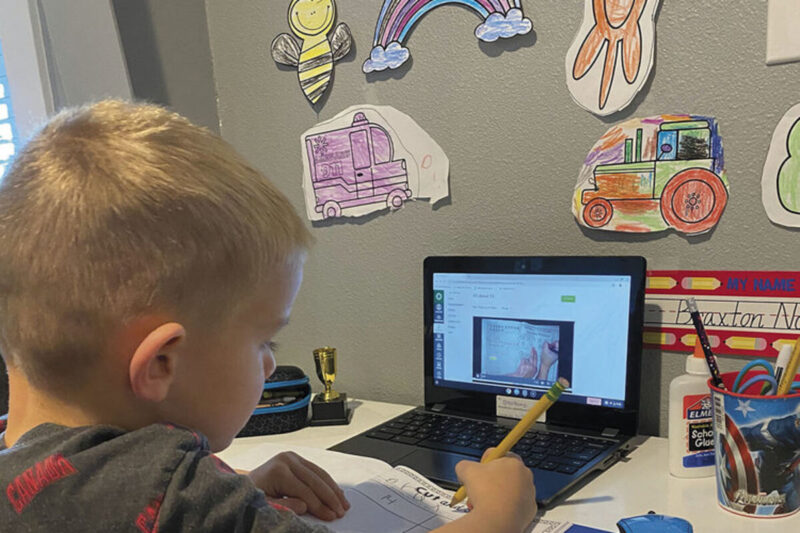Kelly Kenoyer
The Northern family starts their day at 6 a.m., waking up first to feed themselves, and then to feed their farm animals. But once they’re back inside, the day doesn’t stay so idyllic for the kids.
Remote schooling has been the “new normal” since COVID hit in March, but despite significant improvements to the remote learning systems over the summer, it’s not working for everyone.
Jenna Northern’s two boys, 11-year-old Conner and 5-year-old Braxton, attend Hawthorne Elementary, and have loved school and pre-school when they could go in person. But now that school is made up of timed tests, worksheets and Zoom calls, “there are tears every day,” Northern said.
Both boys start the day with a timed test to check up on their learning, “then the kindergartener always has worksheets in the morning.” Those come from weekly packets Jenna picks up at the school each week — right now Braxton is working on learning the numbers 1 through 20. If he gets frustrated with the task, it can completely end his productivity.
“Some mornings, it seems simple; and other mornings, it’s like I don’t even know what 14 is,” Northern said.
While Braxton works on those worksheets, his mom spends 30 minutes reading with Conner to improve his skills.
At 8 a.m., the boys both take part in Zoom meetings with their classes, and they love to see their peers and engage with the teacher, Northern said. But that’s only feasible if the internet is working, and that’s not always the case.
“It lasts, usually, an hour, as long as it’s working. Yesterday, our house or the school didn’t have good enough internet,” she said last week. “Yesterday, literally every live Zoom froze. You could hear all the kids talking in the background, but no one is moving.”
Sweet Home Schools Director of Instruction & Technology Colleen Henry said it’s difficult for a lot of families outside of town to get online — something she wasn’t fully prepared for as the district planned its remote learning over the summer.
“I didn’t realize, specifically about our community. Just how the geography and topography affects people’s ability to connect,” she said. “There are places in our community that you can’t get a landline and you can’t get actual dial up service, let alone broadband service.”
Still, Henry is working hard to fill gaps where they crop up. The district has purchased 55 internet hotspots and distributed them to families in the area.
Northern said laggy internet seems to happen to everyone in the school, and Henry said national outages from their service providers can cause serious problems.
For instance, Amazon Web Servers had serious outages in mid-November, which caused problems for all kinds of web-based apps the district uses. Amazon eventually said the outage was resolved, but Henry found that the Sweet Home area was still experiencing problems.
“We had lingering issues even after AWS had the green light on their end and said everything was resolved,” Henry said.
Northern said it’s not just the district’s technology though — sometimes it’s her home internet can be spotty on the farm out in Holley.
“So he’s raising his hand waiting to do class participation. And then once our systems catch up, they’re already on to a whole nother assignment,” she said. “It’s not always, but it happens, I would say, 30% of the time.”
That kind of technological misfire can be incredibly frustrating for a 5-year-old still learning how to even sit still in class, let alone navigate the digital world, she said.
Luckily, Northern said, her boys are “blessed” with “rock-star” teachers: Amber Rosa teaches little Braxton and Emma Brock teaches Conner. She said they’ve been incredibly engaged, looking for solutions to technological problems, offering to make games for the boys to make learning fun again, and keeping in close contact with the family even over the summer. Brock taught fourth grade last year, but switched to fifth grade this year to “make sure the kids were already familiar with their teacher” at the beginning of a challenging remote school year, Northern said.
Remote learning is impacting her livelihood as well. The Northerns own a couple small businesses: Northern Farms and Feed, run by Travis Northern, and Magnum Metal Works, run by Jenna.
“We’re working weird hours constantly,” she said. “We just have to tag team our kids throughout.”
The laser engraving company is behind by 60 orders because she has to spend a good part of the day, from breakfast until 1:30 p.m., working with the boys on their frustrated schooling. “It just sucks all the joy out of enjoying your kids,” she said with a sigh.
The boys both get a little bit of “Limited In-Person Instruction,” which amounts to two hours of in-person learning each week, but Northern said it’s not enough. She wants her boys to be learning on site a lot more than that, especially since Conner is struggling with his reading.
As for Braxton, she feels like all the training he got in pre-school about how to sit still and be a student is getting lost, and his frustration is heartbreaking.
“When the frustration starts, it just ruins the whole day,” she said. “He had to draw a picture next to a turkey the other day and he started scribbling, and he’s crying, and his exact words were ‘this is how my heart feels.'”
But Northern looks on the bright side too. She watches a fifth-grader from another family on Wednesdays while his parents are at work, and gets to see her son enjoy that friendship. The two of them work together to finish work for class, and she’s glad to see that kind of collaboration.
“I feel thankful and blessed that we are part of the Hawthorne community,” she said. “The teachers work so hard for their kids, and they say they are their kids too.”





